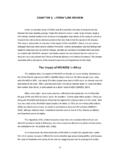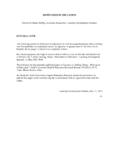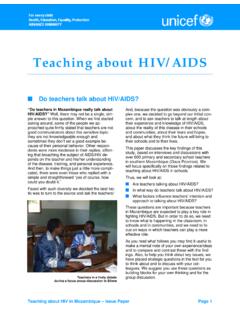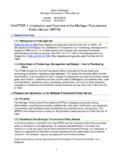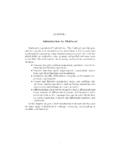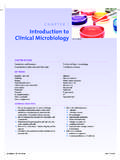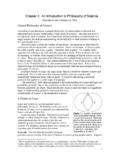Transcription of CHAPTER 1: INTRODUCTION - Learning …
1 CHAPTER 1: INTRODUCTION . This dissertation reports on the results of a cross-sectional survey carried out among primary and secondary school teachers in Mozambique. The purpose of the study was to identify key individual difference variables that impact on teachers' decisions to address HIV/AIDS in the classroom, outside the classroom and in the community at large1. This first CHAPTER of the dissertation presents the problem statement, outlines the purpose of the study, and provides information on the context of the problem. Problem Statement Seventy percent of all new HIV infections take place in Africa (UNAIDS, 2003) and there can be no doubt that HIV/AIDS is no longer only a public health challenge, and it is having a devastating impact on the continent. Poverty, lack of adequate medical facilities, inadequate education, cultural/social barriers and political inertia are but a few of the complex factors that facilitate the spread of this disease which is undermining the hard-won economic and social gains that many African countries were able to make in the last two to three decades (IBRD/World Bank, 2000).
2 The impact of HIV/AIDS is pervasive and far-reaching, affecting individuals and communities not only psychologically but also economically and socially2. Families lose their most productive members to this disease, leaving children and elderly people without means of support. The high cost of the disease wreaks havoc within communities where the already fragile structures are not capable of absorbing further strain. By now startling statistics are driving home the reality of this disease3 and most of the countries that are affected by HIV/AIDS have although often with significant delay put in place programs and activities aimed at combating the spread of HIV/AIDS. Such action plans frequently include a combination of the following elements: mass media campaigns, improved health 1. The three domains of discussion (the classroom, informally in school and in the community) will henceforth be referred to as the educational setting.
3 The educational setting is thus interpreted in the broad sense as the various physical spaces in which teachers play a role in communicating and creating awareness of HIV/AIDS. 2. UNAIDS estimates that HIV/AIDS will result in a loss of more than 20% of gross domestic product in countries most affected by the disease by the year 2020 (IBRD/World Bank, 2002). 3. In 2003 there were million adults and children living with HIV/AIDS in Sub Saharan Africa and the adult prevalence rate was estimated at HIV affects women disproportionately, who are times more likely than men to contract the disease (UNAIDS, 2003). 1. services for early detection and treatment of sexually transmitted diseases that facilitate HIV. infection, voluntary HIV testing, peer education, counseling and awareness activities within the schools, community level awareness building, etc.
4 Initially, the focus of HIV/AIDS interventions was on specific traditionally risk-laden population groups, such as sex workers, truck drivers, and pregnant women. More recently, this approach has shifted to include prevention efforts targeted at larger community groups (Verma, Sureender Guruswamy, 1997), and in particular at children between the ages of 5-14, the so- called window of hope (IBRD/World Bank, 2002) for the countries in Southern Africa that have been so severely affected by HIV/AIDS. These children have escaped infection at birth4 and are assumed not yet to be sexually active5. In addition, at this stage children are still developing attitudes and behavioral patterns and are therefore more easily compared to adults (UNAIDS, 1997). One of the easiest and most direct ways of reaching this large target group is through the school system.
5 In a number of countries in Africa but certainly not all a majority of children in this age group go to school at least for some years. And so, by focusing on schools - and particularly on the primary level and lower secondary level - it is hoped that it will be possible to reach children before they drop out from school and before they become sexually active Figure 1 - Children in a primary school in Mozambique (UNAIDS, 1997). Arguments for the importance of focusing on education are based not only on the window of hope but also on a consistently demonstrated strong inverse association between incidence of the disease and level of education ( Pinckney, 1996; Weir & Knight, 2000) an association that also exists for other diseases such as malaria and cholera (Vandemoortele & Delamonica, 2000). In addition, HIV/AIDS affects young girls and women disproportionately and since they are often easier taken out of school, it becomes important to catch them before they leave (in countries with high levels of infection, such as Botswana, Malawi, Swaziland, and Zimbabwe for every 15-19 year old boy infected there are five to six girls infected in the same age group).
6 4. There is a 35% chance of transmission of HIV from mother to child during delivery or through breast milk if no preventive action is taken (UNICEF, accessed 03/27/04). 5. 60% of all new HIV infections are among those in the age-group of 15-24 (UNAIDS, 2003). 2. Within this strategy of reaching children in schools and in their communities, teachers are expected to play a very important role as educators about the risk of HIV/AIDS and as facilitators of key knowledge, skills and attitudes. The focus on education as a vehicle for change in HIV/AIDS has generated an increasing volume of research. However, the focus of these studies has generally been on the attitudes, knowledge and behavioral intentions and change among students and young people (cf. Venier, Ross & Akande, 1997; Nwokocha & Nwakoby, 2002;. Brook, 1999, Sikand, Fisher & Friedman, 1996, Davis, Noel, Chan & Wing, 1998; Mkumba &.)
7 Edwards, 1992). Only very few studies have examined the current and potential role of teachers in this context of HIV/AIDS ( Lin & Wilson, 1998; Action Aid, 2003). Purpose This study seeks to identify and further understand key factors that may contribute to teachers' willingness/intent to communicate about HIV/AIDS in the educational setting. The term willingness to communicate about HIV/AIDS in the educational setting is used deliberately to reflect the broad scope of knowledge, attitudes, and skills that teachers are expected to advocate in the overall educational setting. The educational setting is interpreted as the broad set of physical spaces within which teachers interact with students, in other words, formally in the classroom, informally in school, and on formal and informal occasions in the community. The literature review presented in CHAPTER 2 highlights a number of limitations to the research as it has been conducted to date.
8 Specifically, as was mentioned above, research on HIV/AIDS education has been largely restricted to studying the students. In addition, most research on HIV/AIDS education in African countries (as opposed to western settings) has neglected to test key models and theories that may provide useful indications as to how to plan or further refine communication and education interventions (Kelly, 1999). Furthermore research in HIV/AIDS education as a whole has mostly neglected to examine how teachers' attitudes and perceptions of the disease affect the crucial role that they are expected to play as mediators of the Learning process for their students. As a consequence, no research has been done in the African context to understand individual and contextual factors that may contribute to the interpretation teachers have of their role in combating HIV/AIDS and how this affects their practice as teachers.
9 In much of the literature there appears to be an implicit assumption that given the right conditions time, training, curricular space and materials (cf. UNAIDS, 1997). teachers will regardless of their individual characteristics - be the right vehicles to deliver the message and to ensure that students acquire the knowledge and develop the attitudes and skills that they need to effectively address the threat of HIV. This stands in contrast with what we know today about how variables such as attitudes, experience, social norms, among others, can influence behavioral intent and on behavior. 3. This study addresses some of the limitations of HIV/AIDS research by using a theoretical framework as the basis for the initial inquiry of these contributing factors and by studying a target group that has traditionally been neglected in HIV/AIDS education research.
10 A combination of two theoretical frameworks which in other behavioral research have been relatively stable and consistent predictors of behavior and behavioral intent are used. Specifically, this study combines Attitude Function Theory (Katz, 1960) and key elements of the Theory of Planned Behavior (Azjen, 1985) to examine how the attitudes, perceptions of social norms and perceived behavioral control of primary and secondary school teachers in Mozambique impact on their willingness to communicate about HIV/AIDS in the broad educational context (formally and informally in schools and in communities). In addition, the study examines how a number of other individual characteristics of teachers (such as their level of experience with HIV/AIDS) impact on willingness to communicate about HIV/AIDS. In summary, the study is intended to: Examine to which extent the three traditional predictors of behavioral intent in the Theory of Planned Behavior (Azjen, 1988) attitudes, perceived social norms, and perceived behavioral control - predict teachers' willingness to communicate about HIV/AIDS.

